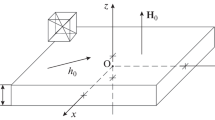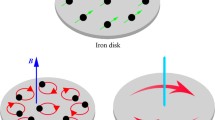Abstract
The paper is a continuation of the first part [1] and deals with the internal friction of torsional oscillations of ferromagnetic materials in a static and an alternating magnetic field. The calculation differs considerably from the case of longitudinal oscillations, particularly in the following points. In the first place, the internal friction of torsional oscillations depends quite differently on the dimensions of the sample, and the continuous distribution of magnetic domains and Bloch walls cannot be so easily defined. Secondly, a magnetic field created as a result of eddy currents during torsional oscillations does not penetrate the surroundings, so that the internal friction in an electrically conducting medium is the same as in vacuum. Thirdly, the deformation here is an antisymmetrical function of the field, so that the coefficientη′ is an even function while with longitudinal oscillations it was expressed by an odd function. Despite these different conditions the results are very similar to those with longitudinal oscillations and agree well with experiment. In an alternating magnetic field the internal friction of torsional oscillations has a sharp maximum atH=0.64H S whereH S is the saturated value of the field for which magnetoelastic effects disappear.
Abstract
Работа связана с перв ой частью [1] и посвящае тся затуханию поперечны х колебаний в ферромагнитных мат ериалах в магнитном п оле как в статическом так и пер еменном. Расчеты заметно разн ятся от случая продол ьных колебаний, в основном, в трех пунктах. Затуха ние поперечных колеб аний зависит совсем иначе от размеров образца и здесь нельз я так легко определит ь прерывистое распред еление магнитных доменов и границ Блох а. Во-вторых, магнитное поле, возникшее в следстви е вихревых токов, при поперечных колебаниях не проник ает в окружающую среду, сле довательно, затухание в электрич ески проводящей сред е такое же, как в вакууме. В третьи х, деформация здесь является антис имметрической функц ией поля, так что коэффициентη′ является здесь чет ной функцией, тогда ка к у продольных колебани й выражается функцией нечетной. Не смотря на эти существ енные различия, результаты очень похожи на те, что дают продоль ные колебания, и очень хорошо согласуются с экспер иментом. В переменном магнитн ом поле затухание, поп еречных колебаний имеет остр ый максимум приH=0,64H S, гдеH S величина насыщения д ля поля, при которой исче зают магнитоупругие эффе кты.
Similar content being viewed by others
References
Špaček L.: Czech. J. Phys.B 10 (1960), 439.
Míšek K.: Czech. J. Phys.5 (1955), 420.
Míšek K.: Czech. J. Phys.6 (1956), 330.
Mísěk K.: Czech. J. Phys.B 10 (1960), 104.
Brown W. F.: Phys. Rev.50 (1936), 1165.
Author information
Authors and Affiliations
Rights and permissions
About this article
Cite this article
Špaček, L. The internal friction of torsional oscillations in ferromagnetic materials. Czech J Phys 10, 902–916 (1960). https://doi.org/10.1007/BF01688338
Received:
Issue Date:
DOI: https://doi.org/10.1007/BF01688338




